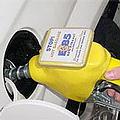 美國汽車所燃燒的乙醇與生質燃料將因法律規定而增加。根據2008年開始實行的能源法案,美國必須使用7.76%的再生燃料,幾乎是2007年4.46%的兩倍。美國總統布希在2007年12月簽署的「能源自主與安全法」而開始推動此政策。
美國汽車所燃燒的乙醇與生質燃料將因法律規定而增加。根據2008年開始實行的能源法案,美國必須使用7.76%的再生燃料,幾乎是2007年4.46%的兩倍。美國總統布希在2007年12月簽署的「能源自主與安全法」而開始推動此政策。
2007年11月,美國國家環保局(EPA)根據先前的法令宣布,再生燃料的比例必須達到4.46%,相當於每年必須在交通燃料上加入至少54億加侖的可再生燃料。
而根據新出爐的「能源自主與安全法」,美國國家環保局將此標準進一步增加至7.76%,相當於每年至少加入90億加侖的再生燃料。
此法案詳列了每年需摻入的可再生燃料將逐年遞增,在2022年時達到360億加侖。
為了達到此標準,美國國家環保局每年算出以百分比為單位的標準,此標準適用於煉油廠,進口商與非氧化的汽油混合廠,各單位需決定再生燃料的最少使用量。
目前美國半數的燃料皆有摻入乙醇,至多佔容量的10%,此燃料稱為E10。在一些地區則混入85%乙醇的燃料,稱為E85,可應用於使用混合燃料的交通工具。
根據「快用再生燃料聯盟」(Renewable Fuels Now Coalition)於2007年10月所做的民意調查,74%的受訪人認為應該增加使用國內生產的再生燃料,例如乙醇。
 身為再生燃料協會會長,同時也是「快用再生燃料聯盟」一員的迪寧(Bob Dinneen)指出:「美國人民一面倒的希望,乙醇以及其他再生燃料要在美國未來的能源中扮演更重要的角色;繼續依賴外國進口的石油並不為大家所採納,而乙醇等可再生燃料有機會為我們國家的能源帶來一個新的、更永續的方向。」
身為再生燃料協會會長,同時也是「快用再生燃料聯盟」一員的迪寧(Bob Dinneen)指出:「美國人民一面倒的希望,乙醇以及其他再生燃料要在美國未來的能源中扮演更重要的角色;繼續依賴外國進口的石油並不為大家所採納,而乙醇等可再生燃料有機會為我們國家的能源帶來一個新的、更永續的方向。」
美國國家環保局估計,在2012年時,此標準將有助每年減少使用39億加侖石油,並減少一千三百萬噸的溫室氣體排放 - 相當於減少230萬輛汽車的碳排放。
然而有一些環保人士否定了再生燃料,他們說在現有的科技下,使用乙醇的車效率比使用石油的車效率要低,因此會排放更多的溫室氣體。「美國合作社」(Co-op America)在日前對國會的陳情信上寫道:「利用玉米製造乙醇需要使用大量的能源、水以及土地,把糧食當成燃料,等同於搶走世界上最窮的一群人的食物。」
為了避免糧食與燃料間的爭端,一些人認為使用非糧食作物提煉成的纖維素乙醇是最好的方案,可能的原料包括牛糞、動物圈欄的肥料、雜柴薪、柳枝稷(Swtichgrass),或甚至是廢輪胎。
The amount of ethanol and biodiesel Americans burn in their cars and trucks is increasing by law. The 2008 renewable fuels standard will be raised to 7.76 percent, nearly doubling the current standard of of 4.66 percent to comply with the new energy bill enacted late last year. The increase is in response to the Energy Independence and Security Act, which President George W. Bush signed in December.
Last November, the U.S. Environmental Protection Agency, EPA, announced a renewable fuels standard of 4.66 percent based on previous law that mandated at least 5.4 billion gallons of renewable fuels be blended into the nation's transportation fuels this year.
But now the EPA is raising the standard to 7.76 percent to comply with the new minimum of 9.0 billion gallons of renewable fuel that the Energy Independence and Security Act requires.
The act increases the overall volume of renewable fuels that must be blended each year, reaching 36 billion gallons in 2022.
To achieve these volumes, EPA annually calculates the percentage-based standard, which applies to refiners, importers and non-oxygenate blenders of gasoline. Based on the standard, each of these parties determines the minimum volume of renewable fuel that it must use.
About half of the gasoline used today in the United States is blended with ethanol at levels of up to 10 percent by volume, called E10. Ethanol blends at higher volumes, such as 85 percent, or E85, are available in some areas for use in flexible-fuel vehicles.
According to a national poll released in October 2007 by the Renewable Fuels Now Coalition, 74 percent of Americans queried believe the use of domestically produced renewable fuels like ethanol should be increased.
"By overwhelming margins, Americans want renewable fuels like ethanol to play a larger role in our nation's energy future," said Renewable Fuels Association President Bob Dinneen, a member of the Renewable Fuels Now Coalition. "The consequences of continuing our dependence on foreign oil are unacceptable.
Renewable fuels like ethanol offer our nation an opportunity to go in a new, more sustainable energy direction."
The EPA estimates that the renewable fuels standard program will cut petroleum use by up to 3.9 billion gallons and greenhouse gas emissions by up to 13.1 million metric tons annually by 2012 - the equivalent of eliminating the greenhouse-gas emissions of 2.3 million cars.
But some environmentalists are resisting renewable fuels, saying that ethanol fueled cars are less efficient and using current technologies can even produce more global warming emissions than gasoline fueled cars. "The corn that goes into ethanol takes massive amounts of energy, water, and land to produce, and using it for fuel could take away food from the world's poorest peoples," says Co-op America in a recent letter-writing campaign to Congress.
To avoid the food-fuel controversy, some view cellulosic ethanol made from non-food crops as the best option. Possible feedstocks include cattle manure, yard waste, logging slash, switchgrass, even scrap tires.
全文及圖片詳見 :ENS





